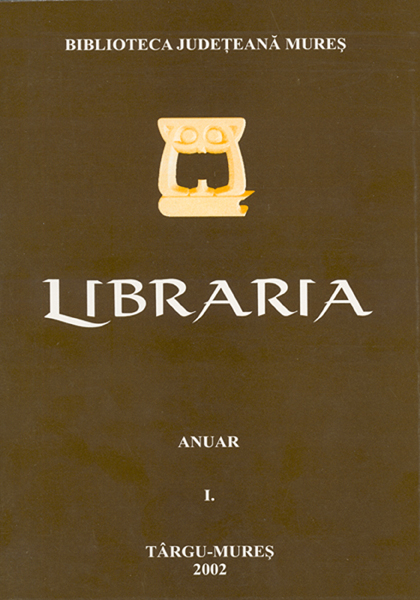Tipografi lyonezi din secolul al XVI-lea în colecţiile Bibliotecii Academice Clujene
Lyon printers from the 16th century in the collections of the Cluj Academic Library
The old book
Author(s): Elena DamianSubject(s): Cultural history, Museology & Heritage Studies, Other, Local History / Microhistory, 16th Century, Scientific Life
Published by: Biblioteca Județeană Mureș
Keywords: Libraria; Biblioteca Județeană Mureș; biblioteconomie; bibliologie; carte veche; carte bibliofilă; istorie locală; servicii de bibliotecă; Biblioteca Teleki; carte veche românească;
Summary/Abstract: 1445 – a moment that indicates a sudden change in the cultural evolution and developement of book diffusion. In the middle of the 16th century, at Mainz, was created the first printing house from Europe. During five decades, the number of such „printing houses” became larger and larger – there were over 250 offices in the second half of the 15th century. Lyon is considered to be one of the most important typographical centers from Europe. It was establish in 1473 and became famous all over the world because of the distinctive artistic value of its printed works. Besides, there were arround 50 offices in this town and they were all developping in a specific way, with no kind of forbiddennes. During the 16th century, many famous typographs have worked at Lyon: Barthélemy Buyer, who’s name is connected with the first steps of french typography; Martin Husz – who realized the first illustrated book from France; Johann Trechsel – a very educated and inventive person; Josse Bade; Sebastian Gryphe etc.The works of all those typographs can be found at Cluj Napoca, at the Academy’s Library. Thus, Sebastian Gryphe is represented by 69 of his printed works; there are the texts of some famous authors, such as: Macrobius Ambrosius, Cicero, Titus Livius, Sallustius Caius Crispus etc. His son, Antoine Gryphe is also represented by his work: 13 copies from Cicero, Iacopo Sannazaro, Vergilius Polidorus etc. Jean de Tournes is famous for the elegance of the letters used for printing, for the truthfulness of the information transmitted. There are 25 copies of his works that can be admired at Cluj Napoca along with those printed by his son, Jean II de Tournes.There are many typographs, and booksellers at the same time, in the 16th century. Some of them are also represented at Cluj; Guillaume Rouille (Rovilius), who’s belief was that „typography does not mean a job, but an art” – 39 copies; Antoine Vincent (Vincentius), one of the richest booksellers at the middle of the 16th century – 19 copies. The books printed at Lyon are properly represented at Cluj Napoca; their value does not consist only in their age, but also because of their exowners, some of the most important cultural personalities from Transylvania.
Journal: Libraria. Studii și cercetări de bibliologie
- Issue Year: I/2002
- Issue No: 1
- Page Range: 157-183
- Page Count: 27
- Language: Romanian

